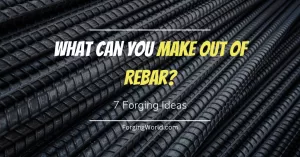From the resounding clang of the hammer against steel to the smoky fumes that waft through the air, blacksmithing is both an art and a craft.
But how does this age-old practice affect our environment?
In this blog post, we will explore whether blacksmithing is harmful or helpful to the environment. We will also go over some of its Pros and Cons and what steps you can take to reduce your carbon footprint.
Is Blacksmihting Harmful to the Environment?
Blacksmithing can be harmful to the environment in several ways. It can produce smoke and release gas pollutants into the air from forging. It can also produce noise pollution from the banging of hammers and other tools.
However, blacksmithing can also be helpful to the environment. Blacksmiths often repurpose and reuse most of their raw materials, that otherwise would have been thrown away. They also tend to implement eco-friendly practices, whenever possible, to lower their carbon footprint.
Pros and Cons of Blacksmithing
Now that we’ve explored the potential environmental impacts of blacksmithing, let’s look at some of its Pros and Cons.
Pros of Blacksmithing for the Environment
Reduce waste: As mentioned above, blacksmiths often reuse and repurpose most of the steel and raw materials. This can reduce the overall materials wasted and is a better option than sending them to landfills.
Long-lasting products: Products and tools created by blacksmiths are often of higher quality and tend to last longer than those produced in mass production. This means that fewer materials have to be used over time, resulting in less overall waste and energy consumption.
Energy efficiency: Modern blacksmith forges use propane for fuel, which has a lower carbon footprint than most other energy sources. Propane also produces more heat and fewer carbon emissions than many other fuels.
Supports local communities: Blacksmiths tend to source most of their materials locally. Not only does this reduce the amount of scrap and materials sent to landfills, but it also reduces the environmental impact of transportation and shipping.
Cons of Blacksmithing for the Environment
Emissions from coal: Traditionally, blacksmith forges were powered by coal, which has a significant environmental impact in terms of air pollution and greenhouse gas emissions.
Noise pollution: Blacksmithing is a noisy process, which can create noise pollution if not done properly. The loud banging of hammers and other tools used in blacksmithing can be disruptive and annoying to nearby wildlife and residents.
Tips to Reduce the Environmental Impact of Blacksmithing
Whether you’re already into blacksmithing or are considering beginning your journey there are several steps you can take to reduce your carbon footprint when blacksmithing.
Here are a few of the most effective ones:
Switch to propane: As mentioned above, propane produces fewer emissions and more heat than coal. If you are still using a coal-powered forge, consider switching to a propane one for a lower carbon footprint.
Reuse and repurpose materials: Whenever possible, try to find uses for scrap metal or other materials that might otherwise be discarded. This can reduce the overall waste produced and help to lower your environmental impact.
Use eco-friendly products: Try to use environmentally friendly cleaning products, low-VOC paints, and other products whenever possible. This can reduce the amount of toxins released into the air or water.
Consider renewable energy sources: If you are looking for an alternative to propane, consider using renewable energy sources such as solar or wind power. This can help reduce your carbon footprint even further.
Use proper sound-proofing: If you are planning on blacksmithing indoors, be sure to use proper sound-proofing materials to reduce the noise pollution produced. This will help keep neighbors and wildlife safe from unnecessary noise.
Final Thoughts
Blacksmithing can have both positive and negative impacts on the environment. By following the tips listed above, you can reduce your carbon footprint and do your part to help protect the environment.
As always be sure to always follow safety guidelines when blacksmithing as this can have a huge impact on both people and nature.
With a little bit of care and effort, you can help blacksmithing become more environmentally friendly and safer for future generations.



Pingback: How to Forge a Knife with Only 5 Basic Tools